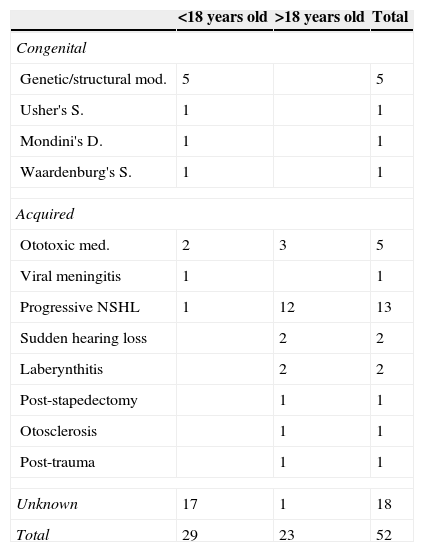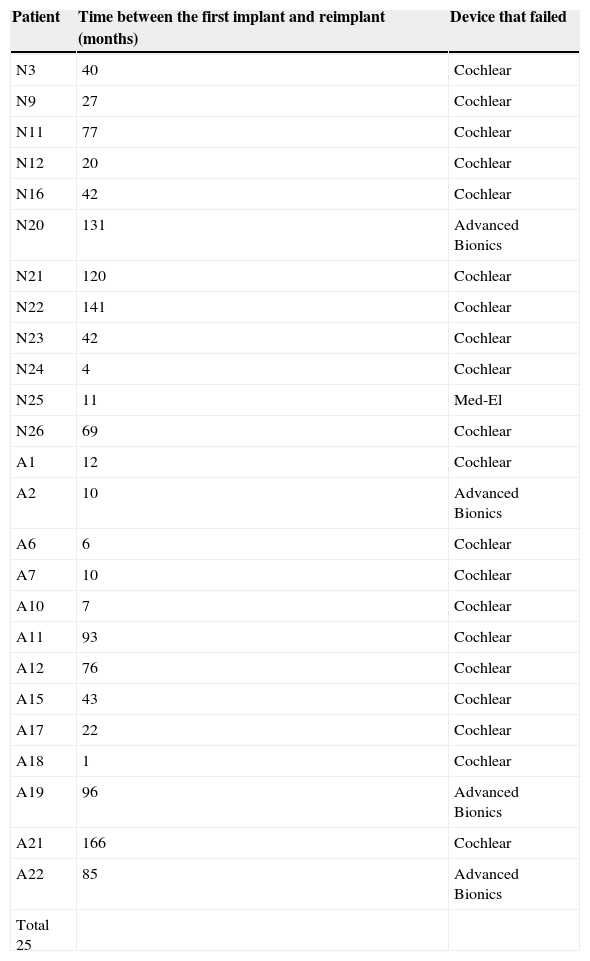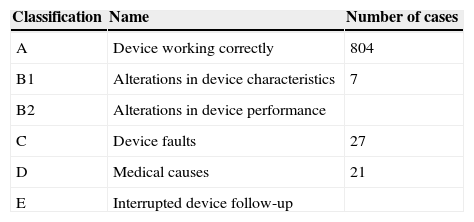The cochlear implant is a surgical procedure that has increased substantially, because the paediatric population is diagnosed and implanted early and because there are increased potential indications. This device has the inherent risk of failure in performance, as dies any active medical device, which is the most common cause of implant removal. Our goal was to understand what the causes that produced removal in our series were, and confirm if these conformed to reality as reviewed in the literature.
MethodsThis was a retrospective, descriptive, observational study of 859 cochlear implant surgeries carried out between October 1991 and May 2011. The causes of implant removal were classified according to the European Consensus Statement on Cochlear Implant Failures and Explantations.
ResultsThe reimplantation rate was 6.16% (n=51). The most common reason for removal was technical device failure (45.5%), followed by infection/rejection (23.6%) and upgrade (12.7%). Less common causes: there were 3 cases (5.6%) of electrode misplacement, 2 cases (3.6%) of labyrinthine ossification, 2 (3.6%) as a result of head trauma, 2 (3.6%) from need for nuclear magnetic resonance imaging and 1 case (1.8%) from psychiatric illness.
ConclusionsCochlear reimplantation is a safe procedure, with a low complication rate. In our centre, it reaches an overall rate of 6.16%. Technical device failure remains the most common cause of this procedure, although there is a significant percentage of reimplantation for device update
El implante coclear es un procedimiento quirúrgico que ha presentado un incremento sustancial, debido a que la población pediátrica es diagnosticada e implantada de forma temprana y al incremento de indicaciones posibles. Este dispositivo tiene el riesgo inherente de presentar fallos en su funcionamiento, siendo esta la causa más frecuente de explantación. Nuestro objetivo es conocer las causas que en nuestra serie nos han llevado a ello y confirmar si se ajusta a la realidad según lo revisado en la literatura médica.
MétodosEstudio retrospectivo observacional y descriptivo de 859 cirugías de implante coclear, realizadas entre octubre de 1991 y mayo de 2011. Las causas de explantación fueron clasificadas según el Consenso Europeo de Fallos y Explantaciones de los Implantes Cocleares.
ResultadosLa tasa de reimplantación fue de 6,16% (n=51). La causa más frecuente de explantación fue el fallo técnico del dispositivo (45,5%), seguida de infección/rechazo del implante (23,6%) y actualización del mismo (12,7%). Entre las causas menos frecuentes se encontraron 3 casos (5,6%) por malinserción de los electrodos, 2 casos (3,6%) de fallo por osificación, 2 (3,6%) por traumatismo craneoencefálico, 2 (3,6%) por realización de resonancia nuclear magnética y un caso (1,8%) por enfermedad psiquiátrica.
ConclusionesLa reimplantación coclear es un procedimiento seguro, que presenta una baja tasa de complicaciones. En nuestro centro alcanza una tasa global de 6,16%. El fallo técnico del dispositivo sigue siendo la causa más frecuente de este procedimiento, con un importante porcentaje de reimplantes por actualización del dispositivo.









